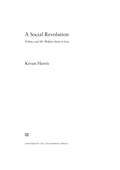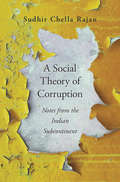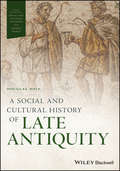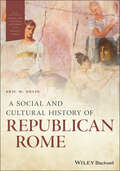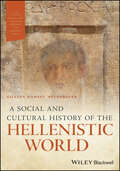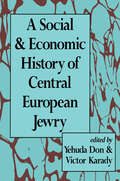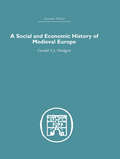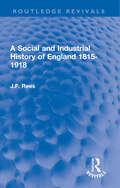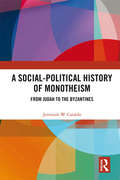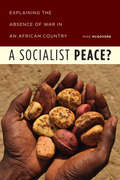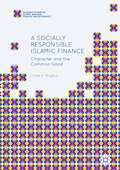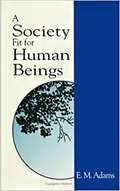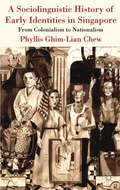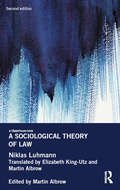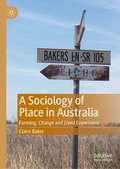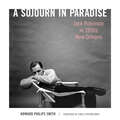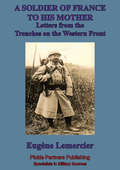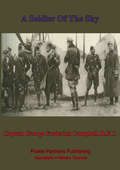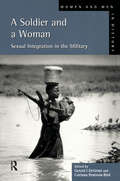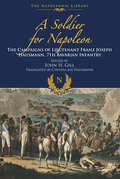- Table View
- List View
A Social Revolution: Politics and the Welfare State in Iran
by Kevan HarrisFor decades, political observers and pundits have characterized the Islamic Republic of Iran as an ideologically rigid state on the verge of collapse, exclusively connected to a narrow social base. In A Social Revolution, Kevan Harris convincingly demonstrates how they are wrong. Previous studies ignore the forceful consequences of three decades of social change following the 1979 revolution. Today, more people in the country are connected to welfare and social policy institutions than to any other form of state organization. In fact, much of Iran’s current political turbulence is the result of the success of these social welfare programs, which have created newly educated and mobilized social classes advocating for change. Based on extensive fieldwork conducted in Iran, Harris shows how the revolutionary regime endured through the expansion of health, education, and aid programs that have both embedded the state in everyday life and empowered its challengers. This focus on the social policies of the Islamic Republic of Iran opens a new line of inquiry into the study of welfare states in countries where they are often overlooked or ignored.
A Social Theory of Corruption: Notes From The Indian Subcontinent
by Sudhir Chella RajanA social theory of grand corruption from antiquity to the twenty-first century.In contemporary policy discourse, the notion of corruption is highly constricted, understood just as the pursuit of private gain while fulfilling a public duty. Its paradigmatic manifestations are bribery and extortion, placing the onus on individuals, typically bureaucrats. Sudhir Chella Rajan argues that this understanding ignores the true depths of corruption, which is properly seen as a foundation of social structures. Not just bribes but also caste, gender relations, and the reproduction of class are forms of corruption.Using South Asia as a case study, Rajan argues that syndromes of corruption can be identified by paying attention to social orders and the elites they support. From the breakup of the Harappan civilization in the second millennium BCE to the anticolonial movement in the late nineteenth and early twentieth centuries, elites and their descendants made off with substantial material and symbolic gains for hundreds of years before their schemes unraveled.Rajan makes clear that this grander form of corruption is not limited to India or the annals of global history. Societal corruption is endemic, as tax cheats and complicit bankers squirrel away public money in offshore accounts, corporate titans buy political influence, and the rich ensure that their children live lavishly no matter how little they contribute. These elites use their privileged access to power to fix the rules of the game—legal structures and social norms—benefiting themselves, even while most ordinary people remain faithful to the rubrics of everyday life.
A Social View of Socotra Island: People, Culture, Heritage
by Nataša Slak Valek Ahmad Abdelmoniem ZedanThis book focuses on Socotra Island, geographically based in Yemen, and aims to explore the island from the social sciences point of view. This book focuses on people indigenous to Socotra, Socotri cultures, heritage and also offers contributions from business, tourism, linguistic, communication, and anthropology. While a lot has been published in natural science about Socotra’s endemic species, biodiversity, and nature in general, social scientific research of the island is very limited. This book addresses therefore addresses this gap and explores various topics of tourism, behaviours, cultures, and language.This book focuses on a clear social science approach of Socotra. The purpose of this book is to publish research about the people, behaviors, heritage, and potential tourism of Socotra. The Socotra Archipelago has long been a land of mystery. It is unknown as a tourism destination for many, however, is a popular destination for adventurers, photographers and travelers who like to travel to remote and undeveloped places. This book explains how Socotra has limited resources of electricity, which is provided by diesel generators, Internet is very slow and limited to certain points on the island. There are no shopping malls or five-star hotels. Roads, schools, and hospitals have been built only recently. This book shoes how these island people do not know the development as we do, which makes it principally interesting to research. Previous interviewers of Socotri people about tourism development in the island have faced many challenges such as language barriers, lack of understanding the meanings and interviewing content, lack of support for the anticipated research results. This book successfully undertakes this challenge as not only in understanding the language, but understanding phenomena like e.g. tourism. Whilst acknowledging the ways in which indigenous island people have never travelled or seen a developed city. Thus, words like ‘developed’, ‘tourism destination’ or ‘washing machine’ may be unfamiliar terms for them. Therefore, new and innovative research methods that are sensitive to Socotra people were implemented in the creation of this book.
A Social and Cultural History of Late Antiquity (Wiley Blackwell Social and Cultural Histories of the Ancient World)
by Douglas Boin2019 PROSE Award finalist in the Classics category!A Social and Cultural History of Late Antiquity examines the social and cultural landscape of the Late Antique Mediterranean. The text offers a picture of everyday life as it was lived in the spaces around and between two of the most memorable and towering figures of the time—Constantine and Muhammad. The author captures the period using a wide-lens, including Persian material from the mid third century through Umayyad material of the mid eighth century C.E. The book offers a rich picture of Late Antique life that is not just focused on Rome, Constantinople, or Christianity. This important resource uses nuanced terms to talk about complex issues and fills a gap in the literature by surveying major themes such as power, gender, community, cities, politics, law, art and architecture, and literary culture. The book is richly illustrated and filled with maps, lists of rulers and key events. A Social and Cultural History of Late Antiquity is an essential guide that: Paints a rich picture of daily life in Late Antique that is not simply centered on Rome, Constantinople, or Christianity Balances a thematic approach with rigorous attention to chronology Stresses the need for appreciating both sources and methods in the study of Late Antique history Offers a sophisticated model for investigating daily life and the complexities of individual and group identity in the rapidly changing Mediterranean world Includes useful maps, city plans, timelines, and suggestions for further reading A Social and Cultural History of Late Antiquity offers an examination of everyday life in the era when adherents of three of the major religions of today—Christianity, Judaism, and Islam—faced each other for the first time in the same environment. Learn more about A Social and Cultural History of Late Antiquity’s link to current social issues in Boin’s article for the History News Network.
A Social and Cultural History of Republican Rome (Wiley Blackwell Social and Cultural Histories of the Ancient World)
by Eric M. OrlinProvides students with a balanced understanding of the key aspects of the culture and society of the Roman Republic A Social and Cultural History of Republican Rome is the first undergraduate textbook of its kind to concentrate on the ways Roman societal structures, family dynamics, visual arts, law, religion, and other cultural and intellectual developments contributed to Roman identity between 509 BCE and 14 CE. Drawing from a diverse range of archaeological, epigraphic, and literary sources, author Eric M. Orlin provides insight into the socio-cultural and intellectual issues that shaped both the Roman Republic and the wider Mediterranean world. Thematically organized chapters address the practice of politics in the Roman Republic, explain the concept of patronage and the distinctions between patricians and plebeians, examine the impact of the army and militarism on Roman society, discuss the ties between Roman religion and the Roman state, and more. Chapters include maps, charts, images, and links to further readings in ancient sources and modern scholarship. Throughout the text, discussion of several recurring themes connects individual chapters while helping students critically engage the material. A Social and Cultural History of Republican Rome: Focuses on themes other than politics and the military, such as the position and role of women in the Roman family, the foundation of the Roman legal system, and the topography and growth of the city of Rome Introduces the basic materials available for the study of the Roman Republic, including written, architectural, and numismatic sources Features a brief narrative history of the Roman Republic and an overview of the text’s methodological framework Establishes key points of discussion for students, using comparisons between Roman society and our modern-day world Encourages students to critically examine the problems and issues raised by the material Covering topics in Roman history that are frequently neglected in undergraduate classrooms, A Social and Cultural History of Republican Rome is an excellent primary or supplementary textbook for courses on the Roman Republic as well as broader Roman history classes that incorporate socio-cultural issues.
A Social and Cultural History of the Hellenistic World (Wiley Blackwell Social and Cultural Histories of the Ancient World)
by Gillian Ramsey NeugebauerExplore the detailed and personal stories of real people living throughout the Hellenistic world In A Social and Cultural History of the Hellenistic World, author Gillian Ramsey Neugebauer paints a vivid picture of the men and women of the Hellenistic period, their communities, and their experiences of life. Assuming only minimal knowledge of classical antiquity, this clear and engaging textbook brings to life the real people who lived in the Mediterranean region, the Balkans, around the Black Sea, across North Africa, and the Near East. Rather than focusing on the elites, royals, and other significant figures of the period, the author draws from a wide range of ancient evidence to explore everyday Hellenistic people in their own context. Reader-friendly chapters offer fresh perspectives on well-studied areas of ancient Greek culture while providing new insights into rarely discussed aspects of day-to-day life in the Hellenistic world. Topics include daily technology, food, clothing, housing, travel, working life, slavery, education, temple economies, and more. Containing numerous references, further readings, photographs, and figures, A Social and Cultural History of the Hellenistic World is an excellent textbook for undergraduate and graduate courses in Ancient History or Classical Studies programs, particularly those dedicated to Hellenistic history.
A Social and Economic History of Central European Jewry
by Peter J. KitsonThis volume is a pioneering effort to examine the social, demographic, and economic changes that befell the Jewish communities of Central Europe after the dissolution of the Habsburg Empire. It consists of studies researched and written especially for this volume by historians, sociologists, and economists, all specialists in modern Central European Jewish affairs.The era of national rivalry, economic crises, and political confusion between the two World Wars has been preceded by a pre-World War I epoch of Jewish emancipation and assimilation. During that period, Jewish minorities had been harbored from violent anti-Semitism by the Empire, and they became torchbearers of industrialization and modernization. This common destiny encouraged certain common characteristics in the three major components of the Empire, Austria, Hungary, and the Czech territories, despite the very different origins of the well over one million Jews in those three lands.The disintegration of the Habsburg Empire created three small, economically marginal national states, inimical to each other and at liberty to create their own policies toward Jews in accord with the preferences of their respective ruling classes. Active and openly discriminatory anti-Semitic measures resulted in Austria and Hungary. The only liberal heir country of the Empire was Czechoslovakia, although simmering anti-Semitism and below surface discrimination were widespread in Slovakia. While one might have expected Jewish communities to return to their pre-World War I tendencies to go their independent ways after the introduction of these policies, social and economic patterns which had evolved in the Habsburg era persisted until the Anschluss in Austria, German occupation in Czechoslovakia, and World War II in Hungary. Studies in this volume attest to continuing similarities among the three Jewish communities, testifying to the depth of the Empire's long lasting impact on the behavior of Jews in Central Europe.
A Social and Economic History of Medieval Europe
by Gerald A. HodgettThis excellent and concise summary of the social and economic history of Europe in the Middle Ages examines the changing patterns and developments in agriculture, commerce, trade, industry and transport that took place during the millennium between the fall of the Roman Empire and the discovery of the New World. After outlining the trends in demography, prices, rent, and wages and in the patterns of settlement and cultivation, the author also summarizes the basic research done in the last twenty-five years in many aspects of the social and economic history of medieval Europe, citing French, German and Italian works as well as English. Significantly, this study surveys the present state of discussion on a number of on unresolved issues and controversies, and in some areas suggests common sense answers. Some of the problems of economic growth, or the lack of it, are looked at in the light of current theories in sociology and economic thought. This classic text, first published in 1972, makes a useful and interesting general introduction for students of medieval and economic history.
A Social and Industrial History of England 1815-1918 (Routledge Revivals)
by J.F. ReesFirst Published in 1920, A Social and Industrial History of England 1815-1918 provides within as small a compass as possible, the historical background necessary for the study of modern industrial and social questions. An attempt has been made to show the interaction between political and economic development in the course of nineteenth century by correlating the growth of democratic institutions with the progress of industry. This book is an essential read for scholars and researchers of social history, industrial history, British history, and modern history in general.
A Social-Political History of Monotheism: From Judah to the Byzantines
by Jeremiah W. CataldoIn A Social-Political History of Monotheism, Cataldo shows how political concerns were fundamental to the development of Judeo-Christian monotheism. Beginning with the disruptive and devastating historical events that shook early Israelite culture and ending with the seemingly victorious emergence of Christianity under the Byzantine Empire, this work highlights critical junctures marking the path from political frustration to imperial ideology. Monotheism, Cataldo argues, was not an enlightened form of religion; rather, it was a cultic response to effluent anxieties pouring out from under the crushing weight of successive empires. This provocative work is a valuable tool for anyone with an interest in the development of early Christianity alongside empires and cultures.
A Socialist Peace?: Explaining the Absence of War in an African Country
by Mike McgovernFor the last twenty years, the West African nation of Guinea has exhibited all of the conditions that have led to civil wars in other countries, and Guineans themselves regularly talk about the inevitability of war. Yet the country has narrowly avoided conflict again and again. In A Socialist Peace?, Mike McGovern asks how this is possible, how a nation could beat the odds and evade civil war. Guinea is rich in resources, but its people are some of the poorest in the world. Its political situation is polarized by fiercely competitive ethnic groups. Weapons flow freely through its lands and across its borders. And, finally, it is still recovering from the oppressive regime of Sékou Touré. McGovern argues that while Touré’s reign was hardly peaceful, it was successful—often through highly coercive and violent measures—at establishing a set of durable national dispositions, which have kept the nation at peace. Exploring the ambivalences of contemporary Guineans toward the afterlife of Touré’s reign as well as their abiding sense of socialist solidarity, McGovern sketches the paradoxes that undergird political stability.
A Socially Responsible Islamic Finance: Character and the Common Good (Palgrave Studies in Islamic Banking, Finance, and Economics)
by Umar F. MoghulThis book explores how, through spirituality and the development of character, Islamic financial institutions and Muslim communities can integrate their businesses with contemporary social responsibility initiatives to produce positive social and environmental impact. From the looming environmental crisis to the divide between mainstream and extremist interpretations of Islam, the book addresses significant questions facing Muslim communities - and humanity - and demonstrates why Islam should sit 'at the table' with other faiths and ethical traditions discussing humanity's great obstacles. Unlike existing literature, this work explores the intersections between classical Islamic ethics and spirituality, contemporary Islamic finance and economic markets, and select sustainability and impact initiatives (such as the Equator Principles and UN Principles of Responsible Investment) designed to make the worlds of business and finance responsible for the environments in which they operate and the communities that support them. Drawing on his years of experience in Islamic banking, Moghul addresses these applications in light of real-world practices and dilemmas, demonstrating how Islamic organizations and Muslim communities should embrace the broad range of stakeholders countenanced by the Shari'ah in conversations that affect them. By situating his exploration of Islamic finance in the light of the much larger critical issues of balance, justice, and moderation in Islamic praxis, Moghul creates an interdisciplinary book that will appeal to academics and researchers in economics, finance, business, government and policy, and law.
A Society Fit For Human Beings (Suny Series In Constructive Postmodern Thought Ser.)
by E. M. AdamsArgues for a humanistic cultural reformation to counter our materialistic values and science-dominated intellectual life and shows how this would affect our lives and transform our society.
A Society Organized for War: The Iberian Municipal Militias in the Central Middle Ages, 1000-1284
by James F. PowersPowers explores the evolution and organization of municipal militias on the Iberian peninsula in the middle ages.
A Sociolinguistic History of Early Identities in Singapore
by Phyllis Ghim-Lian ChewWhat role does race, geography, religion, orthography and nationalism play in the crafting of identities? What are the origins of Singlish? This book offers a thorough investigation of old and new identities in Asia's most global city, examined through the lens of language.
A Sociological Approach to Health Determinants
by Toni SchofieldA Sociological Approach to Health Determinants investigates how 'the social' works in determining health and health inequity. Taking a global perspective, the book shines a light on how experiences of health, illness and health care are shaped by a variety of complex social dynamics. Informed primarily by sociology, the book engages with the WHO's social determinants of health approach and draws on contributions from history, political economy and policy analysis to examine issues such as class, gender, ethnicity and indigeneity, and the impact they have on health. <P> A Sociological Approach to Health Determinants is a comprehensive resource that provides a new perspective on the influence of social structures on health, and how our understanding of the social can ensure improved health outcomes for people all over the globe.
A Sociological Theory of Law (International Library Of Sociology Ser.)
by Niklas LuhmannNiklas Luhmann is recognised as a major social theorist, and his treatise on the sociology of law is a classic text. For Luhmann, law provides the framework of the state, lawyers are the main human resource for the state, and legal theory provides the most suitable base from which to theorize on the nature of society. He explores the concept of law in the light of a general theory of social systems, showing the important part law plays in resolving fundamental problems a society may face. He then goes on to discuss in detail how modern 'positive' – as opposed to ‘natural’ – law comes to fulfil this function. The work as a whole is not only a contribution to legal sociology, but a major work in social theory. With a revised translation, and a new introduction by Martin Albrow.
A Sociology of Place in Australia: Farming, Change and Lived Experience
by Claire BakerThis book weaves a social, economic and cultural history of Australia with rare first-hand accounts of the lived experience of change related to farming and agriculture. It provides a rich sociology of how living on the land has changed throughout Australia’s history. The book investigates the complex effects of the state on everyday life, using an historical agricultural case study of place to explore long-running sociohistorical processes of change examined through both a macro and micro sociological lens. This provides a multi-faceted perspective from which to examine economic, social and cultural transformations in each of these contexts and change is examined through multiple sites of expression: public policy and the role of the state; colonial processes of dispossession; social and cultural systems of value; economic change and its consequences; farming practices and lived experience; neoliberalism and globalisation and their social impacts; community decline and trends toward corporate and foreign land ownership. Each of these transformations impact upon lived experience and everyday life and this book provides grounded insight into exactly this relationship and process.
A Sojourn in Paradise: Jack Robinson in 1950s New Orleans
by Howard Philips SmithJack Robinson made his name as a much-sought-after fashion and celebrity photographer during the 1960s and early 1970s, and his work is well documented in hundreds of pages of Vogue, the New York Times, and Life, as well as other publications. However, his personal life remains virtually unknown. In this study of Robinson and his photography, Howard Philips Smith takes an in-depth look at Robinson’s early life in New Orleans, where he discovered his passion for painting, photography, and the Dixie Bohemian life of the French Quarter. A Sojourn in Paradise: Jack Robinson in 1950s New Orleans features more than one hundred photographs taken by the artist, accompanied by detailed commentary about Robinson’s life in New Orleans and excerpts from interviews with the people who knew him when he lived there. Robinson’s photographs of New Orleans reveal the genesis of two unique and fascinating facets of the city’s history and culture: the creation of the first gay Carnival krewes who would make their own unique contribution to the rich cultural history of the city and the formation of the Orleans Gallery, one of the earliest centers of the contemporary art movement blossoming in 1950s America. This detailed study of Jack Robinson’s early life and photography illustrates the contributions of a gifted, gay artist whose quiet spirit and constant interior struggle found refuge in New Orleans, the city where he was able to find himself, for a time, free from society’s grip and open to exploring life on his own terms.
A Solas con el Sr. Darcy
by Abigail Reynolds Teresita García Ruy SanchezUna variación de Orgullo y Prejuicio El Sr. Darcy decide volver a Meryton a advertir a los residentes, particularmenet a la familia Bennet, sobre el Sr. Wickham.
A Soldier Of France To His Mother; Letters From The Trenches On The Western Front
by Theodore Stanton Eugène-Emmanuel LemercierThe story of a renowned French painter who volunteered for the Army during the First World War paints a vivid picture of the horror at the front in his letters home written before his death in 1915."A Bestseller, remarkable for the horrors of the western front conveyed in a spirit of self-sacrifice and filial love."- A Companion to World War One ed. John Horne, Blackwell Publishing, 2012"THE following letters were written by a young French painter who was at the front until the beginning of April, 1915, when he "disappeared" in one of the combats in the Argonne region of France. "Should he be spoken of in the present or in the past?" asks M. André Chevrillon , a friend of the soldier's family, in the preface to the French edition of this book. "Since the day when his mother and grandmother received from him his last communication, a post card bespattered with mud which announced the attack in which he fell, what a tragic silence for these two women who, during eight months, had lived only with these letters, which came almost daily. In his studio, among the pictures in which this young man had fixed his dreams and his visions of an artist, I have seen, piously arranged on a table, all the little square white sheets of this correspondence. What a speechless presence! I did not know then what a soul was there transcribed in these messages to the family hearth - a fully formed soul, which, if it had lived, I feel sure would have spread its fame and its influence far beyond this little home circle and radiated a-wide among the hearts of men.""
A Soldier Of The Sky [Illustrated Edition]
by Captain George Frederick Campbell, R.F.C."Never refuse a fight, is the motto of the Royal Flying Corps." - And so it was with Captain Campbell, one of the earliest British flying aces with five victories to his name. His flying career was abruptly cut short in 1917, after three years in the air, by a bullet which punctured his lung. Filled with tales of his own and his comrades exploits in the air, he wrote his recollections of his wartime service in America on tour as he sought to raise American aid.Author --Captain George Frederick Campbell, R.F.C.Text taken, whole and complete, from the edition published in Chicago, Davis printing works, 1918.Original Page Count - 232 pages.Illustrations - Numerous Illustrations.
A Soldier Unafraid - Letters From The Trenches On The Alsatian Front
by Captain André Cornet-Auquier Theodore StantonNearly 1.7 million French soldiers died in the First World War fighting for their homeland against the invading German Armies; it is difficult to comprehend that hecatomb. It is indeed difficult to comprehend that many lost lives, perhaps the only way to do so is in representative figures such as the Unknown Soldier or by the many memoirs and diaries that have been left behind. One such diary is that of Captain André Cornet-Auquier, a passionate but moral man, well-known for his leadership skills in and bravery on the battlefield. The conditions in which he served on the Alsace front were always tough, being often within forty-five yards of the enemy's front lines, his faith in his cause and God sustained him even in the most trying situations. Despite being in the front line fighting for so long his luck ran out in February 1916, mortally wounded by a shell splinter. A symbol of French stoicism and courage he died beloved by his men, one of his sergeants said "It is not a spectacle often witnessed, -- that of soldiers, accustomed to face death, weeping like children as they stood round his bier."
A Soldier and a Woman (Women And Men In History)
by Gerard J.De Groot C Peniston-BirdThe question of women's role in the military is extremely topical. A Woman and a Soldier covers the experiences of women in the military from the late mediaeval period to the present day. Written in two volumes this comprehensive guide covers a wide range of wars: The Thirty Years War, the French and Indian Wars in Northern America, the Anglo-Boer War, the First and Second World Wars, the Long March in China, and the Vietnam War. There are also thematic chapters, including studies of terrorism and contemporary military service. Taking a multidisciplinary approach: historical, anthropological, and cultural, the book shows the variety of arguments used to support or deny women's military service and the combat taboo. In the process the book challenges preconceived notions about women's integration in the military and builds a picture of the ideological and practical issues surrounding women soldiers.
A Soldier for Napoleon: The Campaigns of Lieutenant Franz Joseph Hausmann: 7th Bavarian Infantry (Napoleonic Library)
by Franz Joseph HausmannFills a very noticeable gap in the history of the Napoleonic Wars by providing a good description of what it was like to be a member of the Royal Bavarian Army.HistoryNetThe letters and diaries of Lieutenant Franz Joseph Hausmann are here placed in the context of the military events of the period by renowned historian John Gill. They stem from Hausmanns first campaign in 1805 in the war against Austria, followed by the 1806 and 1807 campaigns in Prussia and Poland. In 1809 he was in action against the Tyrolean insurrection and he also fought at Abensberg and Zniam. He was only twenty-three when he embarked on the ill-fated 1812 invasion of Russia and served as part of the Bavarian corps that was shattered in this cataclysmic campaign. He survived to describe the 1813 campaign and the 1814 campaign in France when the Bavarians switched sides and fought against Napoleon.With additional commentary by John Gill on the Bavarian Army and its campaigns and battles, this book is an important, authoritative addition to the works on the Napoleonic Wars.
